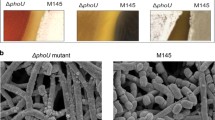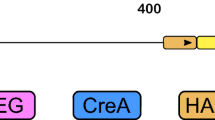Abstract
Expression of thePDA1 gene in the ascomyceteNectria haematococca MPVI (anamorph:Fusarium solani) is induced by exposure of mycelium to pisatin, an isoflavonoid phytoalexin produced by its host plant, garden pea. ThePDA1 gene encodes a cytochrome P-450 monooxygenase which detoxifies pisatin. Regulatory elements controlling transcription from thePDA1 promoter were identified using a homologousNectria in vitro transcription system through analysis of 5′ deletions, specific oligonucleotide competition, and fusion of upstream segments to a heterologous promoter. A promoter-distal element which provided transcriptional activation was localized to a 35-bp region positioned − 514 to − 483 upstream of the transcriptional start site. This 35-bp region binds a previously characterized pisatin-responsive DNA-binding factor (PRF) and thus may provide pisatin-responsive control of transcription. A second promoter-proximal positive-acting region was found to be necessary for promoter transcription in both homologous and heterologous extracts, and so is likely to bind less gene-specific transcription activator(s). A negative-acting element located between these two positive regions may act to make the positive-acting elements interdependent. The identification of an activator responding to pisatin provides a model for the control of a number of genes and processes controlled by host-specific signals, particularly the flavonoids.
Similar content being viewed by others
References
Carey M, Leatherwood J, Ptashne M (1990) A potent Ga14 derivative activates transcription at a distance in vitro. Science 247:710–712
Cubero B, Scazzocchio C (1994) Two different, adjacent and divergent zinc finger binding sites are necessary for CREA-mediated carbon catabolite repression in the proline gene cluster ofAspergillus nidulans. EMBO J 13:407–414
Desjardins AE, VanEtten HD (1986) Partial purification of pisatin demethylase, a cytochrome P-450 from the pathogenic fungusNectria haematococca. Arch Microbiol 144: 84–90
Dynan WS, Tjian R (1983) The promoter-specific transcription factor Sp1 binds to upstream sequences in the SV40 early promoter. Cell 35:79–87
Ehrenshaft M, Upchurch RG (1993) Host protein(s) induces accumulation of the toxin cercosporin and mRNA in a phytopathogenic strain ofCercospora kikuchii. Physiol Mol Plant Pathol 43:95–107
Fincham IRS (1989) Transformation in fungi. Microbiol Rev 53:148–170
Fisher RF, Long SR (1992)Rhizobium-plant signal exchange. Nature 357:655–660
George HL (1993) Biochemical characterization of pisatin demethylases from fungal pea pathogens. Ph.D. Dissertation, Cornell Univ., Ithaca, NY, 171p
Gonzales FJ (1989) The molecular biology of cytochrome P450s. Pharmacol Rev 40:243–288
Hirschi KD (1994) Partial characterization of the PDA genes inNectria haematococca MPVI. Ph.D. Dissertation, Univ. of Arizona, Tucson, AZ, 204p
Hjorth AL, Pears C, Williams JG, Firtel RA (1990) A developmentally regulated trans-acting factor recognizes dissimilar G/C-rich elements controlling a class of cAMP-inducibleDictyostelium genes. Genes Dev 4:419–432
Kamper JT, Kamper U, Rogers LM, Kolattukudy PE (1994) Identification of regulatory elements in the cutinase promoter fromFusarium solani f.sp. pisi (Nectria haematococca). J Biol Chem 269:9195–9204
Kistler HC, VanEtten HD (1984a) Regulation of pisatin demethylation inNectria haematococca and its influence on pisatin tolerance and virulence. J Gen Microbiol 130:2605–2613
Kistler HC, VanEtten HD (1984b) Three non-allelic genes for pisatin demethylation in the fungusNectria haematococca. J Gen Microbiol 130:2595–2603
LaThangue NB, Rigby PWJ (1988) Trans-acting protein factors and the regulation of eukaryotic transcription. In: Hames BD, Glover D (eds) Transcription and splicing. IRL Press, Oxford, pp 3–42
Lin Y-S, Carey MIT, Ptashne M, Green MR (1988) GAL4 derivatives function alone and synergistically with mammalian activators in vitro. Cell 54:659–664
Mellor J (1993) Multiple interactions control the expression of yeast genes. In: Broda P, Oliver SG, Sims PFG (eds) The eukaryotic genome: organization and regulation. Cambridge University Press, Cambridge, pp 275–320
Morris PF, Ward EWB (1992) Chemoattraction of zoospores of the soybean pathogen,Phytophthora sojae, by isoflavones. Physiol Mol Plant Pathol 40:17–22
Nehlin JO, Carlberg M, Ronne H (1991) Control of yeastGAL genes by MIGI repressona transcriptional cascade in the glucose response. EMBO J 10:3373–3377
Ohkuma Y, Horikoshi M, Roeder R, Desplan C (1990) Binding site-dependent direct activation and repression of in vitro transcription byDrosophila homeodomain proteins. Cell 61: 475–484
Pieterse CMJ, Derksen A-MCE, Folders J, Govers F (1994) Expression of thePhytophthora infestans ipiB andipiO genes in planta and in vitro. Mol Gen Genet 244:269–277
Punt P, Kramer C, Kuyvenhoven A, Pouwels PH, Hondel CAMJJ van den (1992) An upstream activating sequence from theAspergillus nidulans gpdA gene. Gene 120:67–73
Reimmann C, VanEtten HD (1994) Cloning and characterization of thePDA6-1 gene encoding a fungal cytochrome P450 which detoxifies the phytoalexin pisatin from garden pea. Gene 146: 221–226
Ruan Y, Straney DC (1994a) In vitro transcription from theNectria haematococca PDA1 promoter in a homologous extract reflects in vivo pisatin-responsive regulation. Curr Genet 27:46–53
Ruan Y, Straney DC (1994b) PCR-based construction of promoter/G-free templates for in vitro transcription analysis allows selection of plasmids with optimal activity in homologous extracts. Gene 146:227–232
Ruan Y, Kotraiah V, Straney DC (1995) Flavonoids stimulate spore germination inFusarium solani pathogenic on legumes in a manner sensitive to inhibitors of cAMP-dependent protein kinase. Mol Plant Microb Interact. (in press)
Smith DA (1982) Toxicity of phytoalexins: fungitoxic activities. In: Bailey JA, Mansfield JW (eds) Phytoalexins. Blackie, Glasgow, pp 218–252
Soeller WC, Poole SJ, Kornberg T (1988) In vitro transcription of theDrosophila engrailed gene. Genes Dev 2: 68–81
Spaink HP, Wijffelman CA, Pees E, Okker RJH, Lugtenberg BJJ (1987)Rhizobium nodulation genenodD as a determinant of host specificity. Nature 328:337–340
Straney DC, VanEtten HD (1994) Characterization of thePDA1 promoter ofNectria haematococca and identification of a region that binds a pisatin-responsive DNA binding factor. Mol Plant Microb Interact 7:256–266
Talbot NJ, Ebbole DJ, Hamer JE (1993) Identification and characterization ofMPG1, a gene involved in pathogenicity from the rice blast fungusMagnaporthe grisea. Plant Cell 5:1575–1590
Tsai SM, Phillips DA (1991) Flavonoids released naturally from alfalfa promote development of symbioticGlomus spores in vitro. Appl Environ Microbiol 57:1485–1488
Turbek CS, Li D, Choi GH, Schardl CL, Smith DA (1990) Induction and purification of kievitone hydratase fromFusarium solani f.sp.phaseoh. Phytochemistry 29:2841–2846
Van den Ackerveken AGFJM, Van Kan JAL, Joosten MHAJ, Muiseis JM, Verbakel HM, De Wit PJGM (1993) Characterization of two putative pathogenicity genes of the fungal tomato pathogenCladosporium fulvum. Mol Plant Microb Interact 6:210–215
Van den Ackerveken GFJM, Dunn RM, Cozijnsen TJ, Vossen P, Van den Broek HWJ, De Wit PJGM (1994) Nitrogen limitation induces expression of the avirulence geneavr9 in the tomato pathogenCladosporium fulum. Mol Gen Genet 243:277–295
VanEtten HD, Barz W (1981) Expression of pisatin demethylase ability inNectria haematococca. Arch Microbiol 129: 56–60
VanEtten HD, Matthews DE, Smith DA (1982) Metabolism of phytoalexins. In: Bailey JA, Mansfield JW (eds) Phytoalexins. Blackie, Glasgow, pp 181–217
VanEtten HD, Matthews DE, Matthews PS (1989) Phytoalexin detoxification: importance for pathogenicity and practical considerations. Annu Rev Phytopathol 27:143–164
VanEtten HD, Soby S, Wasmann C, McCluskey K (1994) Pathogenicity genes in fungi. In: Daniels MJ, Downie JA, Osbourn AE (eds) Advances in molecular genetics of plant-microbe interactions, vol 3. Kluwer, Dordecht, pp 163–170
Yamazaki K, Imamoto F (1987) Selective and accurate initiation of transcription at the T-DNA promoter in a soluble chromatin extract from wheat germ. Mol Gen Genet 209:445–452
Yamazaki K-I, Katagiri F, Imaseki H, Chua N-H (1990) TGA1a, a tobacco DNA binding protein increases the rate of initiation in a plant in vitro transcription system. Proc Natl Acad Sci USA 87:7035–7039
Yoshinaga SK, Peterson SL, Hersowitz I, Yamamoto KR (1992) Roles of SWIl, SW12 and SWI3 proteins for transcriptional enhancement by steroid receptors. Science 258:1598–1604
Author information
Authors and Affiliations
Additional information
Communicated by C. van den Hondel
Rights and permissions
About this article
Cite this article
Ruan, Y., Straney, D.C. Identification of elements in thePDA1 promoter ofNectria haematococca necessary for a high level of transcription in vitro. Molec. Gen. Genet. 250, 29–38 (1996). https://doi.org/10.1007/BF02191822
Received:
Accepted:
Issue Date:
DOI: https://doi.org/10.1007/BF02191822




